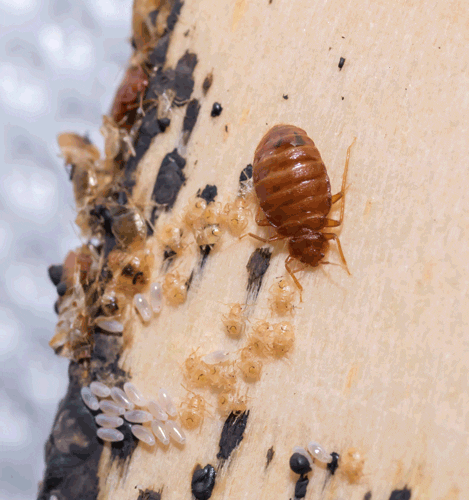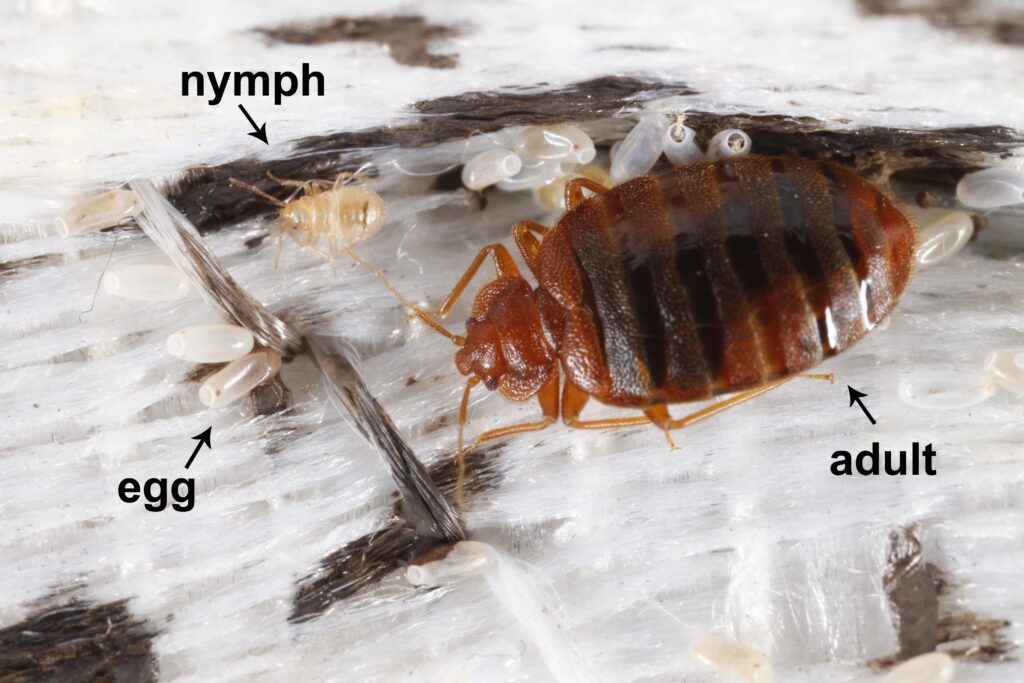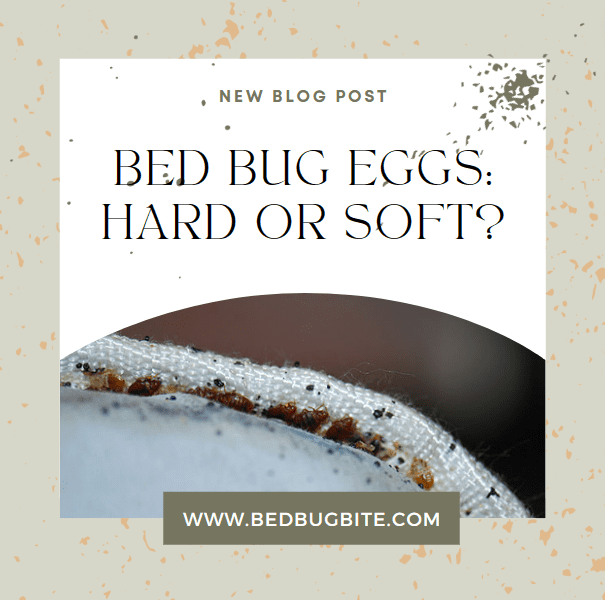Welcome to our in-depth exploration of bed bug eggs, a topic crucial for anyone grappling with these persistent pests. Bed bugs, notorious for their resilience and rapid breeding, pose significant challenges in home and commercial settings. Their life cycle, particularly the egg stage, is often shrouded in mystery, leaving many to wonder about the characteristics of these eggs – are they hard or soft? For even more information on bed bugs click here!
Understanding the nature of bed bug eggs is not just an academic curiosity; it’s a critical component in effective pest control strategies. The eggs of bed bugs serve as the foundation of their life cycle. Being small, typically about 1mm in length, they are often overlooked, yet they play a pivotal role in the proliferation of bed bug populations. They are, in essence, the starting point of any infestation.

The texture of these eggs is a matter of practical importance. A common misconception is that they are hard, akin to seeds or grains of sand. However, this is not entirely accurate. Bed bug eggs are, in fact, more on the softer side, with a certain degree of resilience. This softness is a natural design, allowing the eggs to adhere better to surfaces, which aids in their protection and incubation.
Furthermore, their color, typically a milky white hue, camouflages them against many backdrops, making detection challenging. Learning to identify these eggs is a crucial step in early detection and effective bed bug management.
Bed Bugs Eggs
In tackling this topic, we draw upon a wealth of research and expertise. One such resource is the University of Kentucky’s Entomology Department, which offers extensive insights into bed bug biology and behavior [University of Kentucky Entomology: Bed Bugs]. Their findings align with our observations and experiences in the field, reinforcing our understanding of bed bug eggs.
In delving deeper into the physical characteristics of bed bug eggs, we uncover vital details that not only inform but also arm us in our battle against these pests. The nature of these eggs is more intricate than often perceived. And understanding their physical attributes can significantly enhance our control strategies.
Size and Shape: A Microscopic View
Bed bug eggs, though tiny, hold significant details in their size and shape. Typically, they measure about 1mm in length, comparable to the size of a small grain of rice. Their shape is elongated and ovular, a design that facilitates discreet lodging in cracks and crevices. This minute size and unique shape often make them challenging to spot without magnification, underscoring the need for thorough inspections.
Texture Analysis: Hard or Soft?
The texture of bed bug eggs is a critical factor in determining their resilience. Contrary to common belief, these eggs are not hard and impenetrable. They are, instead, somewhat soft and malleable. This softness, however, does not equate to fragility. The outer covering of the egg, known as the chorion, provides enough protection to withstand mild environmental pressures while remaining vulnerable to targeted pest control methods.
Color and Visibility: Identifying Eggs in Your Home
Identifying bed bug eggs in your home is a key step in early infestation control. These eggs are typically a translucent to milky white color, allowing them to blend seamlessly with light-colored fabrics and surfaces. Over time, as the embryo develops, the egg may darken slightly. The challenge in spotting these eggs lies in their size and color. Which necessitate a keen eye or magnification tools for effective detection.
Our understanding of the physical characteristics of bed bug eggs is bolstered by research from reputable sources such as the Environmental Protection Agency (EPA). Their comprehensive guide on bed bugs provides valuable insights into identifying and managing these pests EPA: Bed Bugs. This information complements our expertise and experience, providing a solid foundation for our discussions on bed bug egg characteristics.
As we continue to explore the fascinating yet complex world of bed bug eggs, it becomes increasingly clear that knowledge is our most powerful tool. Understanding the size, texture, and visibility of these eggs is crucial in our ongoing efforts to detect, prevent, and eradicate bed bug infestations.
Turning our focus to the embryonic development within bed bug eggs, we delve into a crucial phase of the bed bug life cycle. This stage is not just about the transformation from egg to nymph. But also about understanding the factors influencing this transition. It’s here that the bed bug’s future resilience and ability to proliferate begins.
Stages of Embryo Growth
The embryonic growth within a bed bug egg is a fascinating process. Initially, the egg contains a tiny embryo, barely visible to the naked eye. As the embryo develops, it undergoes several stages of growth, each stage bringing it closer to emerging as a nymph. This development is rapid, often taking less than a week in ideal conditions. The speed and efficiency of this process are key reasons why bed bug populations can escalate so quickly in infested areas.
Duration of Egg to Nymph Transition
The duration from egg to nymph is critical in bed bug control efforts. Typically, this transition takes about 6 to 10 days, depending on environmental factors like temperature and humidity. Higher temperatures can accelerate this process, while cooler conditions may prolong it. Understanding this timeline is essential for effective treatment planning and monitoring. Ensuring that interventions are timed to target the bed bugs at their most vulnerable stages.

Factors Influencing Embryonic Development
Several environmental factors play a significant role in the development of bed bug embryos. Temperature and humidity are the most significant, with optimal conditions speeding up development. Conversely, adverse conditions can slow down or even halt the process. Additionally, factors like the presence of pesticides or other chemicals in the environment can impact the viability of the eggs.
Research from institutions like Cornell University’s Department of Entomology provides valuable insights into these developmental processes Cornell University Entomology: Bed Bugs. Their studies help us understand not just the how, but the why behind bed bug egg development. Offering crucial information for effective pest management.
In summary, the journey from egg to nymph is a complex and finely tuned process, influenced by a myriad of environmental factors. As we unravel the mysteries of embryonic development in bed bug eggs, we gain invaluable insights into their life cycle. This knowledge is pivotal in devising strategic, effective approaches to bed bug management and control.
The resilience of bed bug eggs is a topic often surrounded by myths and misconceptions. To effectively combat bed bug infestations, it’s essential to separate fact from fiction regarding the durability and survivability of these eggs. Understanding the true nature of their resilience is key to developing effective pest control strategies.
Hardness vs. Durability: What Really Matters
While the texture of bed bug eggs is softer than often assumed, their durability should not be underestimated. The softness of the eggshell, paradoxically, contributes to its resilience, allowing the egg to slightly deform without breaking. This characteristic is crucial for surviving in the diverse environments bed bugs often find themselves in. Therefore, the focus should be on the egg’s ability to withstand environmental stresses, rather than solely on its hardness.
Environmental Factors Affecting Egg Survival
Environmental conditions play a pivotal role in the survival of bed bug eggs. Factors such as temperature, humidity, and exposure to chemicals significantly influence their viability. For instance, extreme temperatures, both high and low, can be detrimental to egg survival. Likewise, certain pesticides are more effective against eggs than others, making the choice of pest control methods critical.
Common Misconceptions About Bed Bug Egg Strength
There are several misconceptions regarding bed bug egg strength. One common belief is that bed bug eggs are impervious to most forms of mechanical pressure. In reality, while they are resilient, they are not invincible. Physical methods such as vacuuming or steam treatment can be effective in eliminating these eggs. Another myth is that all pesticides are equally effective against bed bug eggs, which is not the case. Some pesticides have little to no impact on the eggs, underscoring the need for informed choices in pest control.
The resilience of bed bug eggs is well-documented in scientific literature. As seen in resources like the Journal of Economic Entomology [Journal of Economic Entomology: Bed Bug Eggs]. This research provides valuable insights into the physical and environmental factors that influence the survival of bed bug eggs, enabling us to approach pest control with a more nuanced understanding.
Tools and Techniques for Identifying Bed Bug Eggs
Identifying bed bug eggs requires a keen eye and sometimes the aid of tools. Visual inspection is the primary method, involving a thorough examination of common bed bug hiding places like mattress seams, furniture joints, and baseboards. For enhanced detection, magnifying glasses or UV lights can be useful. UV lights can make the translucent eggs more visible against certain backgrounds. Additionally, bed bug detectors or monitors can be strategically placed to identify the presence of bed bugs and their eggs in a specific area.
DIY Methods vs. Professional Extermination Approaches
When it comes to bed bug egg removal, there are both DIY methods and professional extermination approaches. DIY methods include meticulous cleaning, vacuuming, and the use of steam. These methods can be effective but often require repeated effort and attention to detail. Professional exterminators, on the other hand, offer more comprehensive solutions. They have access to specialized equipment and pesticides that are not available to the general public, which can be more effective in fully eradicating bed bug eggs.
Preventive Measures to Avoid Future Infestations
Prevention is key in avoiding future bed bug infestations. Simple practices like regular cleaning, reducing clutter, and inspecting second-hand furniture before bringing it into the home can significantly reduce the risk of infestation. Encasing mattresses and box springs with protective covers is another effective strategy, as it limits the number of hiding places for bed bugs and their eggs.
The Centers for Disease Control and Prevention (CDC) provides valuable information on bed bug prevention and control. Their guidelines reinforce the importance of combining detection, eradication, and preventive measures for effective bed bug management.
In summary, tackling bed bug eggs requires a multifaceted approach, combining detection, removal, and preventive strategies. By understanding and applying these methods effectively, individuals can significantly reduce the likelihood of bed bug infestations and maintain a bed bug-free environment.
In the realm of bed bug control, choosing the right methods to tackle bed bug eggs is crucial. Both chemical and non-chemical solutions play a significant role in managing these pests effectively. Understanding the advantages and limitations of each approach can greatly enhance your ability to control and prevent bed bug infestations.
Safe and Effective Chemical Treatments
Chemical treatments for bed bug eggs involve the use of insecticides that are specifically formulated to target these pests. These products come in various forms, including sprays, powders, and aerosols. It’s crucial to choose insecticides that are labeled as effective against bed bug eggs and to use them according to the manufacturer’s instructions. Safety is paramount; hence, opting for products that are safe for indoor use and non-harmful to humans and pets is important. Professional exterminators often have access to more potent chemicals that are not available to the general public, offering a higher level of efficacy.
Natural and Eco-Friendly Alternatives
For those seeking more natural solutions, there are several eco-friendly alternatives. Diatomaceous earth, a naturally occurring powder, can be effective against bed bugs by dehydrating them. Essential oils like lavender, tea tree, and eucalyptus have also been touted for their repellant properties, although their efficacy in completely eradicating bed bugs is debated. Heat treatment is another non-chemical option, where high temperatures are used to kill bed bugs and their eggs. This method requires specialized equipment and is often best handled by professionals.
Evaluating the Effectiveness of Various Control Methods
Evaluating the effectiveness of bed bug control methods is essential to ensure successful eradication. This involves not only assessing the immediate impact on bed bug populations but also monitoring for any signs of resurgence over time. Continuous evaluation and possibly alternating between different methods may be necessary for complete control, especially in severe infestations.
Organizations like the National Pest Management Association (NPMA) offer resources and guidance on bed bug control methods National Pest Management Association: Bed Bugs. Their expertise provides valuable insights into the pros and cons of various control strategies, helping users make informed decisions.
Addressing frequently asked questions about bed bug eggs is a vital aspect of any comprehensive bed bug management guide. By clarifying common queries, we can empower individuals with the knowledge they need to effectively tackle bed bug issues. These FAQs cover a range of topics, from survival conditions to identification challenges, providing essential insights for both prevention and eradication.
Can Bed Bug Eggs Survive Certain Temperatures?
One of the most frequent questions concerns the temperature tolerance of bed bug eggs. These eggs can survive in a wide range of temperatures, but extreme conditions can be lethal. Generally, temperatures above 120°F (49°C) for a sustained period can effectively kill bed bug eggs, making heat treatment a viable option. Conversely, freezing temperatures can also be effective, but the eggs must be exposed to temperatures of 0°F (-18°C) or lower for at least four days. This knowledge is crucial for implementing temperature-based control strategies.
How to Differentiate Between Bed Bug Eggs and Other Pests?
Differentiating bed bug eggs from those of other pests can be challenging due to their small size and appearance. Bed bug eggs are typically about 1mm in length, oval-shaped, and a milky white color. They are often found in clusters and located in hidden areas, such as mattress seams or behind wallpaper. In contrast, eggs of other pests like fleas or dust mites may differ in size, shape, or color. Close inspection and sometimes professional identification may be required for accurate differentiation.
Tips for Ongoing Monitoring and Prevention
Continuous monitoring and preventive measures are key in managing bed bug infestations. Regular inspections of potential hiding spots, using bed bug monitors, and maintaining cleanliness can help in early detection. Encasing mattresses and box springs, reducing clutter, and being vigilant when traveling or bringing second-hand furniture into your home are effective preventive strategies. Awareness and proactive measures can significantly reduce the risk of bed bug infestation.
The Environmental Protection Agency (EPA) provides a wealth of information on bed bug prevention and control, offering valuable tips and guidelines for dealing with these pests. Drawing from such reputable sources enhances the credibility and effectiveness of our answers to these frequently asked questions.
In summary, addressing these common questions about bed bug eggs helps demystify many aspects of bed bug control. By providing clear and accurate information, we empower individuals to take informed actions in both preventing and eradicating bed bug infestations.
As we conclude our comprehensive exploration of bed bug eggs and their role in infestation control, it’s clear that understanding these minute yet crucial elements is key to effective bed bug management. The journey through the characteristics, development, and eradication of bed bug eggs equips us with the knowledge needed to combat these resilient pests effectively. This guide aims not only to inform but also to empower readers in their efforts to maintain bed bug-free environments.
Summarizing Key Takeaways
Key takeaways from our discussion include the understanding that bed bug eggs are small, soft, and resilient, requiring targeted strategies for detection and eradication. Environmental factors such as temperature and humidity play a significant role in their development and survival, influencing control methods. Combining various strategies, including both chemical and non-chemical solutions, is often necessary for thorough management and prevention of bed bug infestations.
Encouraging Vigilance and Regular Checks
Vigilance and regular inspections are paramount in preventing and controlling bed bug infestations. Regular monitoring, employing preventive measures, and being proactive in response to early signs of bed bugs can greatly reduce the likelihood and severity of infestations. Staying informed and alert is the best defense against these persistent pests.
Additional Resources and Support for Bed Bug Control
For further information and support in bed bug control, resources like the National Pest Management Association (NPMA) and the Environmental Protection Agency (EPA) offer valuable insights and guidelines. The NPMA website (National Pest Management Association: Bed Bugs) provides extensive information on pest management, while the EPA’s bed bug resource (EPA: Bed Bugs) offers practical advice on prevention and control.
In closing, our deep dive into the world of bed bug eggs reveals that effective control is a combination of knowledge, vigilance, and appropriate action. By staying informed and proactive, we can successfully manage and prevent bed bug infestations, ensuring a healthier and more comfortable living environment.




